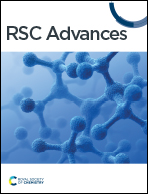Efficient removal of humic acid in water using a novel TiO2 composite with biochar doping
Abstract
Titanium dioxide modified with biochar (Ti–C) was prepared by a sol–gel method for the degradation of humic acid (HA) in aqueous solutions. Under identical conditions, Ti–C contained less TiO2 and showed better HA degradation capacity than that of pure TiO2, and had ca. 20% higher HA removal rate than that of simple Ti–C adsorption. Photocatalytic degradation of HA with Ti–C had an efficient removal rate of 50% at pH = 3, which was ca. 28% higher than that at pH = 7 (HA = 10 mg L−1), while a higher reaction temperature, longer lighting time and larger Ti–C dosage were conducive to HA photocatalytic degradation. SEM micrographs showed that Ti–C had a much rougher surface than the original biochar, and EDS results of Ti–C indicated that its carbon content increased up to 26.2% after biochar doping. Ti–C had an evident anatase structure and a typical SiO2 structure, as revealed by XRD analysis. TOC and GC-MS analysis indicated that HA was effectively degraded and transformed into harmless carbon dioxide. Superoxide radicals were the main active radicals produced for the efficient degradation of humic acid, while hydroxyl radicals and electron–holes also contributed to HA decomposition in Ti–C systems. This work is expected to be helpful for the innovative preparation of titanium dioxide as a low-cost photocatalyst for the degradation of humic acid in water.



 Please wait while we load your content...
Please wait while we load your content...